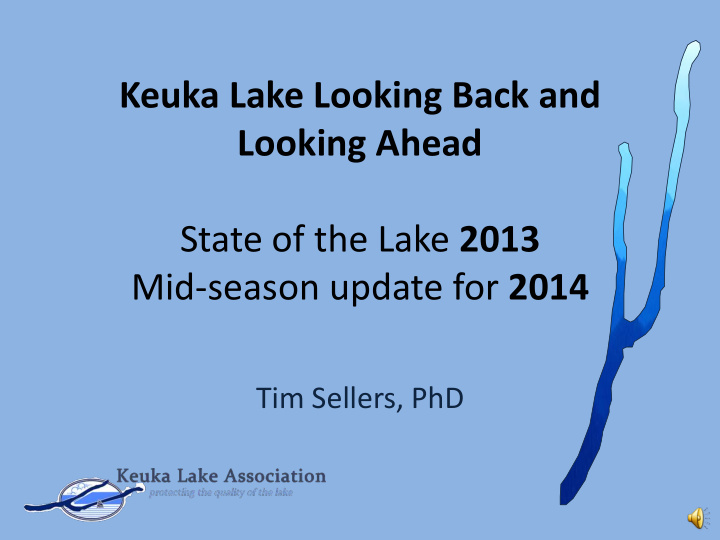



Keuka Lake Looking Back and Looking Ahead State of the Lake 2013 Mid-season update for 2014 Tim Sellers, PhD
Tim Sellers, PhD KLA Science/Water Quality Advisor Training Limnologist / Aquatic Biologist Research lakes, rivers, oceans Keuka College Director, Center for Aquatic Research Professor of Biology and Environmental Science Associate Vice President, Academic Programs
Talk Outline • State of the lake 2013 – Updates with long term history • Submersible Probe – Variation under the waves – Blue-green algae • May 2014 storms – Data from the storm – Predictions for future
2013 State of Keuka Lake Nutrient levels ( Phosphorus ) • Averaged 6.5 ppb, up 1.1 ppb from 2012, • Below long-term average of 7.28 ppb Water clarity • Averaged 7.9 m, similar to 2012 levels • 1.8 m above the long-term average of 6.1 meters Algae levels • averaged 0.67 ppb, down from 2012 • well below the long-term average of 2.6 ppb
6.5 2013
7.9 2013
( = algae) Average = 2.6 2013
Keuka Lake Total Phosphorus 25 16 sites within lake 20 Total Phosphorus ( g/L) 15 10 5 0 -5 Apr May Jun Jul Aug Sep Oct Nov 2013
Keuka Lake Chlorophyll a 3.0 16 sites within lake 2.5 Chlorophyll a ( g/L) 2.0 1.5 1.0 0.5 0.0 Apr May Jun Jul Aug Sep Oct Nov 2013
2013
Submersible Water Quality Probe Depth Temperature Chlorophyll a (= algae) Cyanobacteria (= blue green algae) pH Conductivity (= salts)
Keuka Lake Where is the algae/phytoplankton? Temperature ( C) 0 5 10 15 20 25 30 0 Low surface 5 10 Depth (m) 15 High Middle 20 Site 1 25 Site 2 Temperature Low bottom 30 0.0 0.5 1.0 1.5 2.0 2.5 3.0 3.5 Chlorophyll a ( g/L)
Cyanobacteria (= Blue green algae) • Type of phytoplankton / algae • Generally inhabits surface (not deep) Reduces light in lake: bad for good algae • Many species Most harmless Some produce toxic chemicals • Very LOW levels in Keuka! • New probe allows instant sample Microcystis
Data from Dr. John Halfman , Hobart and William Smith Colleges
State of the Lake • 2013 data show the lake is in generally good health • Improving trends in many important parameters ( algae , phosphorus ) • Cyanobacteria levels continue to be low (but present!) • Submersible probe yielding great results so far • May 2014 storm dumped a lot of phosphorus in lake could be a major issue later this summer, following years. – More macrophytes (seaweed) – More cyanobacteria
Thank you for your dedication to protecting Keuka Lake! • Continue to the “Listen to the Lake” • “If not now, when? If not us, who?” • Contact me: Tim Sellers tsellers@keuka.edu (315) 279-5685
Recommend
More recommend